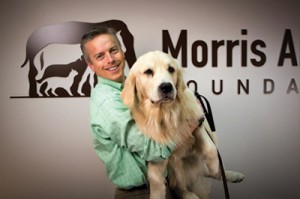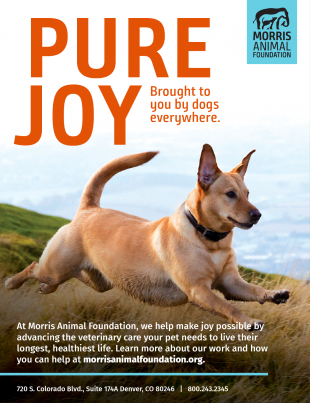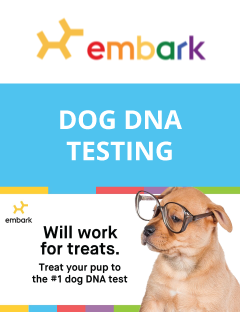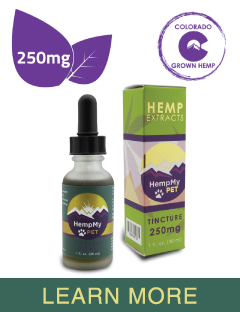Golden Study Celebrates Its Second Year
 By: David Haworth, DVM, PhD, President/CEO, Morris Animal Foundation
By: David Haworth, DVM, PhD, President/CEO, Morris Animal Foundation
I’m writing today while Bridger, my 16-month-old furry child, is lying on my feet. Bridger is an enthusiastic, unapologetic ball of energy and joy, all contained in a beautiful Golden Retriever body. And, even though he doesn’t know it, he is a hero for all dogs. Bridger is a participant in Morris Animal Foundation’s Golden Retriever Lifetime Study, which enters its third year in September.
The Golden Retriever Lifetime Study is the largest, longest and most complete study ever conducted in veterinary medicine. It will unquestionably, fundamentally change the way we understand disease in dogs.
Through owner questionnaires, veterinary exams, blood tests and genetic sequencing, we will know nearly everything there is to know about each of the 3,000 Golden Retrievers in the study, and better yet, we will collect this information every year of their lives. This level of information gathering only becomes relevant later, when the dogs start to become sick. While it is nothing I want to think about while my Golden boy is lying on my feet, in time every one of these beautiful animals will get sick and eventually, pass away.
What makes these dogs heroes, however, is that when one group of them develops a disease (cancer or diabetes, for instance), there will be another group that doesn’t, and with the data collected we can look for and discover the differences between the two groups. That is the real benefit of studies like this one, because you can’t identify the differences without first collecting all the data. By understanding the differences between the two groups’ nutrition, genetics and environments, we can start to piece together risk factors that cause dogs to develop a specific disease.
We now have more than 1,900 dogs enrolled in the study. That is 1,900 families who hate disease in their beloved companions so much that they are willing to participate fully in this study. It is not easy, but it is so important.
We will be conducting this study for the next 10 to 12 years, and our hope is to continue to follow these dogs’ puppies, and possibly their puppies, for much longer, but, of course, good science requires money. We’re raising that funding, and meanwhile dogs like Bridger are doing their parts—by giving of their time for the sake of all dogs.
If you would like to help Morris Animal Foundation understand cancer and other diseases in dogs, I encourage you to visit us today at www.CanineLifetimeHealth.org.
With your help we can provide a brighter, healthier future for all our furry children.







